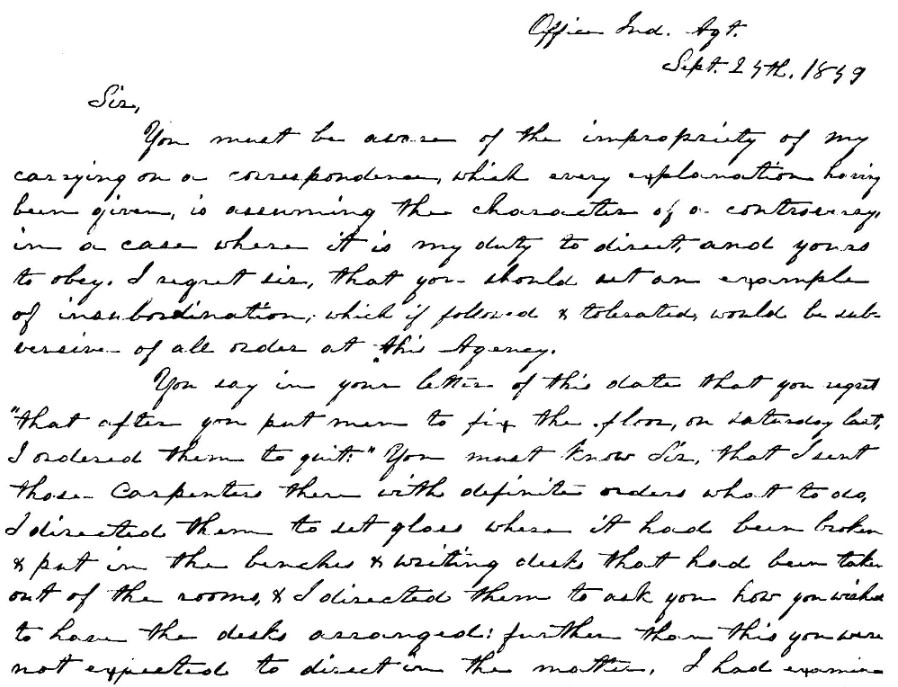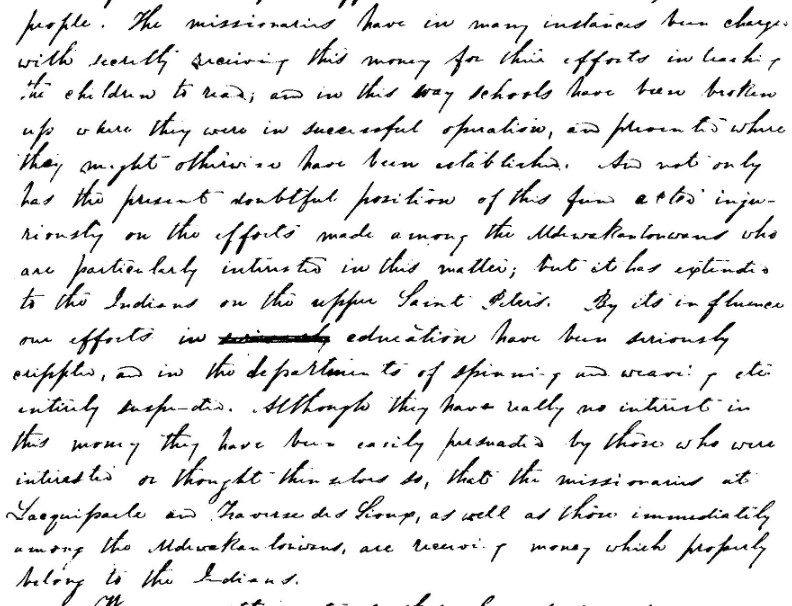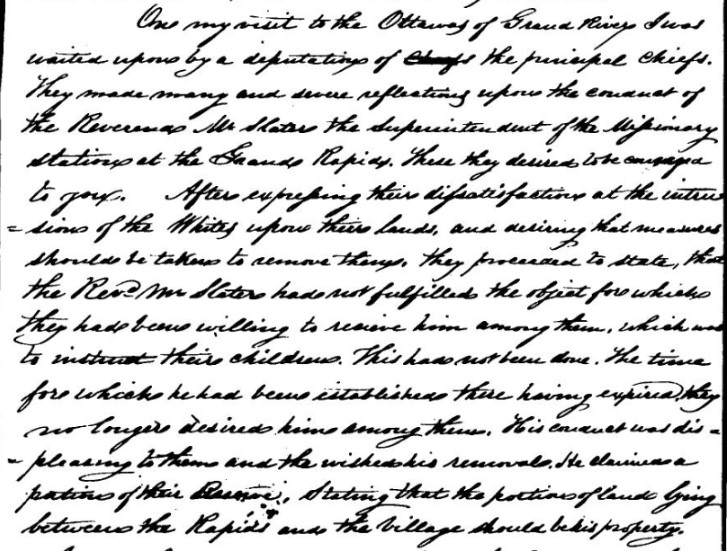Throw the Book at Them: The Perilous Project of Indian Education in the 19th Century

The title phrase is drawn from colloquial jurisprudence; to “throw the book” at someone is to charge them with every crime for which they might be culpable, the goal being to “convict” them on all counts—to change their own convictions and thus reform their behavior. When one reflects that Native Americans were placed and kept upon government reservations by force of arms, and that their children were often taken from them to be “civilized” in day or residential schools, a metaphor invoking punishment and microaggression unfortunately applies as well to Indian education.
Native Americans had real books figuratively thrown at them in Indian schools. Native American Tribal Histories, 1813-1880 from Readex includes lists of the actual texts used in Indian schools during the process of cultural erasure. This one is from the Winnebago Indian School in northern Iowa in 1849:
Inventory of books on hand in Winnebago School
Emerson’s North American Arithmetic 1st Part
5 Doz.
Smith’s Arithmetic
1 Doz.
McGuffie’s Eclectic Spelling Book
about one half of which are much worn
2 Doz.
Smith’s First Book in Geography
one half of which are also much worn
1 Doz.
Parley’s Geography
1 Doz.
Emerson’s Second Reader, many much worn
17 Copies
McGuffie’s Second Reader
1-1/2 Doz.
Webster’s Dictionary
4 Copies
Slates
32
Mitchell’s Atlas
½ Doz.
Parley’s U.S. Histories
2 Copies
Books on [illegible]
4 Copies
Testaments
20 Copies
Mitchell’s Geography
2 Copies
Sanderson’s First Reader
(most of them worn badly)
10 Copies

Here’s a list from the Wichita Indian Agency in Oklahoma that includes other instructional materials as well as books, and the prices paid in November 1877.

The freight bills and vouchers executed in support of Indian education provide granular detail as to curriculum and the material culture at the missions and in the schools. For example, we learn that in February 1877 the Sac and Fox Agency School (south of present-day Tulsa, Oklahoma) acquired a Singer sewing machine. It cost sixty dollars and weighed one hundred pounds as shipped from Lawrence, Kansas.

for the Sac and Fox Mission School, Feb. 13, 1877. From Native American Tribal Histories, 1813-1880.
The voucher below lists what was known as “queensware” purchased for that same school and the related school for the Absentee Shawnee Indians. The purchase is for tea service but queensware applies to tableware generally; Wedgwood china would be an example familiar to readers today. Apparently “civilizing” Native Americans required habituating them to English tea served on English china.

Sac and Fox and Absentee Shawnee Schools, Feb. 16, 1877. From Native American Tribal Histories, 1813-1880.
Differences of opinion in the fitting out of a schoolhouse for the Winnebago Indians got Presbyterian missionary David Lowry in trouble with Minnesota Indian agent Jonathan E. Fletcher in 1849. Lowry was worried that gaps in the floor of the school’s sewing room would lead to lost needles and pins, and that the building was unserviceable in other significant respects. Fletcher reminded Lowry that missionaries served at the pleasure of the government, not the other way around, and did not get to make demands as to circumstances. But he did order that work be done on the building, and the government paid for that work.
You must be aware of the impropriety of my carrying on a correspondence, which every explanation having been given, is assuming the character of a controversy in a case where it is my duty to direct and yours to obey. I regret sir, that you should set an example of insubordination, which if followed & tolerated would be subversion of all order at this Agency.
You say in your letter of this date that you regret “that after you put men to fix the floor, on Saturday last, I ordered them to quit.” You must know Sir, that I sent those carpenters there with definite orders what to do, I directed them to set glass where it had been broken & put in the benches & writing desks that had been taken out of the rooms, & I directed them to ask you how you wished to have the desks arranged; further than this you were not expected to direct in the matter.

Are you an educator (re)negotiating your contract in 2022? Here’s Sarah C. Owen’s contract with Indian agent Henry R. Schoolcraft to serve as teacher at the Mackinac Indian Agency in Michigan Territory in November 1835.
The undersigned hereby expresses her full assent to the terms of the arrangement verbally made this day by the U.S. Indian Department, through Henry R. Schoolcraft, Ind. Agent, in the presence of Capt. John Clitz the Commanding officer of the post, which is to the following effect namely. She will instruct all Indian children & children of Indian descent gratuitously at her school. All who will come, will be received & taught, during any period, however short, and will be supplied without charge, with books and stationery. She will sign (quarterly) receipts for the annual sum of one hundred & fifty dollars, which it is proposed to allow her, from the Civilization fund, towards the support of her school, to commence on the 1st day of October ultimo.
Michilimackinac, November 5th 1835

Despite textbooks, technology such as sewing machines, glass in schoolhouse windows, even dedicated, humane teachers, many of the problems of Native Americans came down to money—too little of it to function in White society. This was the case for Dakota Indians in 1849 when they slighted education in favor of increasing their annuity funds. Missionaries purportedly subsidized by tribal trust funds were forcibly removed from reservations and threatened with violence.
An unattributed account of this situation, likely written by missionary Gideon H. Pond, describes how the Dakota Indians were aroused to “drive off the missionaries” when they were told that $5000 of their annuities would be given to missionaries under the 1837 Treaty with the Sioux.
…as soon as it was known that Major [Lawrence] Taliaferro had recommended that a part of the money which he said these Indians had by treaty “Set apart for schools missions and other beneficial objects under the direction of the President” should be paid to missionaries the Indians were told by some of their advisors that unless they would oppose schools the missionaries would get all their money but if they would break up the schools and drive off the missionaries they might get the money themselves.
In consequence of this an organized opposition to schools and missionaries immediately commenced in this part of the tribe and continued to increase till the schools were broken up, not a single child residing in any village of the Mdewakantonwan being permitted to attend school.

Not only did the Mdewakanton destroy the schools in their own community, they threatened missionaries serving the related Wahpeton band.
The Mdewakantonwan while breaking up the schools among themselves endeavored to stop that among the Warpetonwan at Lac qui Parle but without much success till the year 1842 when in the month of June severe frosts and drought almost entirely destroyed the crops in that region, in consequence of which many of the Warpetonwan of that village to escape starvation came to spend the winter among the Mdewakantonwan. The latter having previous to this stopped all the schools among themselves and repeatedly demanded the money without getting it, were made to believe and told the Warpetonwan that the missionaries at Lac qui Parle were getting on account of the school these several thousand dollars of the Mdewakantonwan money and by presents and promises the Warpetonwan were instigated to break up the school and drive off the missionaries.
Accordingly in the Autumn of 1843 many of the principal men of Lac qui Parle who had until a short time previous never manifested hostility either to the school or missionaries came armed to the mission house and formally ordered the missionaries to leave.

The missionaries did not comply with this order and were not harmed, but school attendance declined and livestock supporting school operations was destroyed. Founding of additional schools among the Dakota ceased. In May 1849 Pond and other interested persons petitioned the government to settle the $5000 education allocation in some way so Native Americans would no longer resent their activities.
The missionaries have in many instances been charged with secretly receiving this money for their efforts in teaching the children to read, and in this way schools have been broken up where they were in successful operation, and prevented where they might otherwise have been established. And not only has the present doubtful position of this fund acted injuriously on the efforts made among the Mdewakantonwan who are particularly interested in this matter, but it has extended to the Indians on the upper Saint Peter’s. By its influence our efforts in education have been seriously crippled, and in the departments of spinning and weaving etc. entirely suspended. Although they have really no interest in this money they have been easily persuaded by those who were interested or thought themselves so, that the missionaries at Lac qui parle and Traverse des Sioux, as well as those immediately among the Mdewakantonwan, are receiving money which properly belong to the Indians.

The annual reports in Native American Tribal Histories, 1813-1880 are invaluable for gaining a sense of what transpired within a tribe or agency from year to year. The agents usually summarized progress at Indian schools, but the substance of Native American education is best found in the annual reports of the teachers and missionaries themselves such as in this 1849 report from Thomas Williamson writing to Indian agent Richard G. Murphy of the school in Kaposia, Minnesota Territory (present-day St. Paul).
When the people of this village were about to proceed on their autumnal hunt, the chief having just returned from receiving their annuities, probably in consequence to what you said to him on that occasion, said they would return here from their hunt before New Year’s day, and then they would all attend school though he should be killed for it. Many others told us that all the young people would attend school as soon as they returned from their fall hunts. I think it was their purpose to do so, but when they returned they were told that the Missionaries were trying to get the five thousand dollars a year which would have been paid to the Indians in money but for a letter sent to their Great father the President purporting to be signed by Wacouta the chief of this village and Mocqui Wachewtah asking for schools…

The 1850 annual report of missionary Gideon H. Pond from the St. Peters Indian Agency shows that the missionaries were not alone in suffering persecution over treaty allocations to education.
Early in the spring a few native women manifested considerable concern for the salvation of their souls and two or three who had never before attended, came to our meetings. This fact, I suppose it was, excited anew the opposition of those who hate reform and several of the chief men of the band in assembly resolved, “That, whereas the Missionaries are possessing themselves of the money which is due us from the U.S. (the $5000) if any natives attend the religious meetings of the Missionaries, they shall be stripped of their clothes, whipped and have their names struck off from the list of the band.”

The Ottawa Indians in Michigan Territory had a well-founded grievance with Catholic missionary Francis Pierz related to lands purchased by him with their money. In his 1836 report to Stevens T. Mason, Michigan Territorial Secretary Kintzing Pritchette described a similar land dispute with Baptist Rev. Leonard Slater who had been retained to conduct a school.
On my visit to the Ottawas of Grand River I was waited upon by a deputation of the principal chiefs. They made many and severe reflections upon the conduct of the Reverend Mr. Slater the Superintendent of the Missionary Station at the Grand Rapids. These they desired to be conveyed to you. After expressing their dissatisfaction at the intrusions of the Whites upon their lands, and desiring that measures should be taken to remove them, they proceeded to state, that the Revd. Mr. Slater had not fulfilled the object for which they had been willing to receive him among them, which was to instruct their children. This had not been done. The time for which he had been established there having expired they no longer desired him among them. His conduct was displeasing to them and they wished his removal. He claimed a portion of their Reserve, stating that the portions of lands lying between the Rapids and the village should be his property.

In closing we’ll circle back to Thomas Williamson’s annual report from Kaposia that includes a page tabulating the academic achievements of Dakota Indian students there in 1849. It also records their attendance and more importantly, states a few of their names. Native American names can be very difficult to render in English or European languages. Readex’s Native American Tribal Histories, 1813-1880 can help us to validate the identities of Native Americans and explore their lives.

Visit the Readex Native American Studies page for information on this collection and more.



